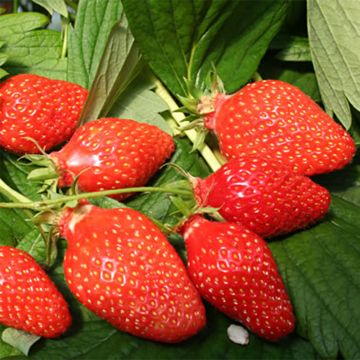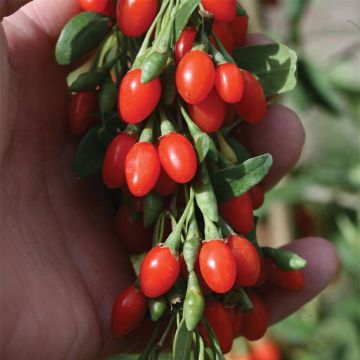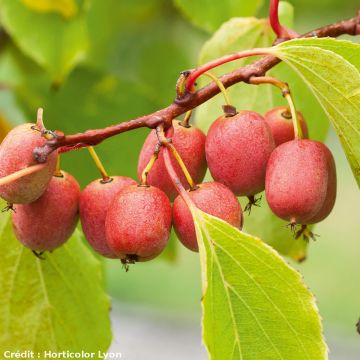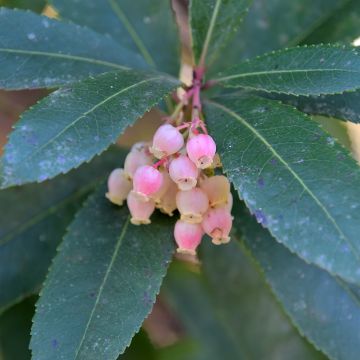

Vitis vinifera Fanny - Grape Vine
Vitis vinifera Fanny - Grape Vine
Vitis vinifera FANNY COV
Common Grape Vine, European Grape, Wine Grape
Special offer!
Receive a €20 voucher for any order over €90 (excluding delivery costs, credit notes, and plastic-free options)!
1- Add your favorite plants to your cart.
2- Once you have reached €90, confirm your order (you can even choose the delivery date!).
3- As soon as your order is shipped, you will receive an email containing your voucher code, valid for 3 months (90 days).
Your voucher is unique and can only be used once, for any order with a minimum value of €20, excluding delivery costs.
Can be combined with other current offers, non-divisible and non-refundable.
Home or relay delivery (depending on size and destination)
Schedule delivery date,
and select date in basket
This plant carries a 6 months recovery warranty
More information
We guarantee the quality of our plants for a full growing cycle, and will replace at our expense any plant that fails to recover under normal climatic and planting conditions.
Description
The Fanny grape is a Hungarian vine variety with a semi-erect, moderately vigorous habit, capable of reaching a height of 3m when trained on a trellis. This variety produces yellow table grapes that turn orange at full ripeness. The flesh is firm and crunchy, juicy with a slightly acidic taste. The large clusters of slightly elliptical berries are not very susceptible to major vine diseases. This vine will thrive in most well-drained, neutral to calcareous soils in sunny locations. It is cold hardy.
The wine grape (Vitis vinifera) grew wild over 5000 years ago in North and Central America, Europe, as well as Central and Eastern Asia. The subspecies sylvestris still exists today as a climbing vine, growing on forest edges and capable of reaching great heights in trees. The current varieties, referred to as grapevine cultivars, belong to the vinifera subspecies (although there are other cultivated species, but they are very minor). Economically, wine grapevines dominate over table grapevines.
Fanny is an interspecific hybrid obtained in 1970 by József Csizmazia, a Hungarian breeder, by crossing the Villard Blanc variety, obtained in the Drôme region, with a hybrid itself resulting from the crossbreeding of (Teli Muskotaly x Olimpia). Fanny contains genes from 3 vine species: Vitis berlandieri, an American vine that provided phylloxera-resistant rootstocks, Vitis rupestris, another American species, and Vitis vinifera, our "classic" grapevine.
This moderately vigorous vine with a semi-erect habit has small to medium-sized leaves, with 5 well-defined lobes and a rather elongated shape. It buds 4 days after Chasselas, a reference variety for vine phenological stages. These leaves have a beautiful bright green colour from the start and often develop beautiful autumn colours, ranging from coppery yellow to red, giving it some ornamental interest. This vine flowers in June-July, producing small greenish-yellow flowers that develop into large, loosely packed fruit clusters.
The berries start off greenish-yellow, then turn golden yellow with hints of orange at full ripeness in late September and October. These medium to large grapes are crisp and very juicy. They can be harvested until mid-October. This variety is highly resistant to downy mildew and botrytis (grey mould), two of the worst vine diseases. It is slightly susceptible to powdery mildew and excoriose, but its overall good disease resistance is a definite advantage for amateur cultivation. It is a good idea to do summer green pruning to remove certain leaves so that the grapes are well exposed to the sun and can develop that beautiful yellow colour, which is a guarantee of their taste quality.
This vine is very hardy (down to -20°C, or even -25°C) and grows in full sun, in neutral to slightly acidic, well-drained soil. It will thrive in ordinary, even rocky soil, as long as it is not too dry.
Fanny grapes can be consumed as table grapes or used for juice, as their flesh is very juicy. For example, they can be used in a vitamin-packed fruit cocktail for breakfast. In general, grapes are rich in B vitamins, a source of fibre and manganese, and they are also rich in antioxidants. They are believed to play a role in preventing cardiovascular diseases, and most importantly, they are a healthy, natural, and delicious dessert. To create original fruit salads, plant a Kiwi, such as the Actinidia deliciosa Kiwi Wonder, a variety with very sweet and non-acidic fruits (female variety, so pair it with a male variety for pollination). For diversification, try Diospyros virginiana SAA Pieper, an early-fruiting American persimmon tree that will give you fruits at the same time as Fanny.
Report an error about the product description
Vitis vinifera Fanny - Grape Vine in pictures
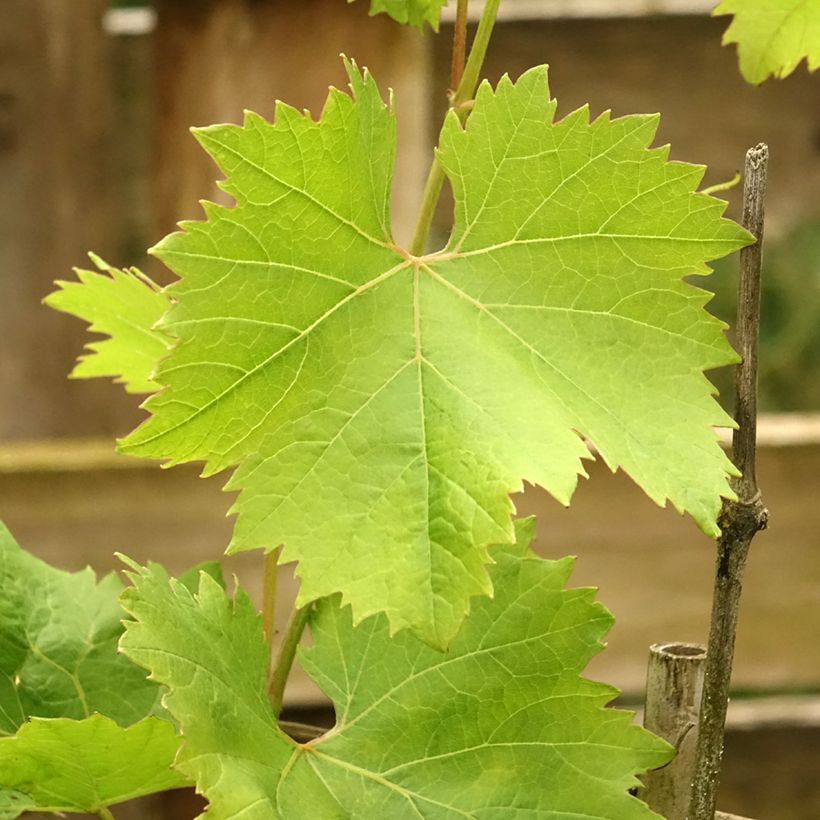



Plant habit
Fruit
Flowering
Foliage
Botanical data
Vitis
vinifera
FANNY COV
Vitaceae
Common Grape Vine, European Grape, Wine Grape
Cultivar or hybrid
Other Grapevines
View all →Planting and care
Since the devastation caused by phylloxera at the end of the 19th century, grapevines are grafted onto different rootstocks resistant to this disease and adapted to different types of soil. These rootstocks come from American varieties naturally armed against this formidable parasite, which itself originates from America.
Plant the Fanny grapevine in autumn, in a deep, well-drained soil, even stony, clayey, and chalky. The vine is not very demanding in terms of the chemical nature of the soil, it can adapt to moderately acidic soil (up to pH 6, because below that there are assimilation blockages of certain trace elements), neutral, and chalky up to pH 8.5 (it is the excess of active limestone that is harmful).
Plant it in a sunny location, sheltered from strong, cold, and dry winds. This variety withstands winter frosts, it is hardy to -20°/-25 °C. Incorporate 3 or 4 handfuls of fruit tree fertiliser and 2 kg of composted manure per vine into the planting soil. Be careful, the roots should not come into contact with the manure. After planting, prune above 2 large buds to obtain the growth of two branches. Keep the most vigorous one and tie it to a stake. Formation pruning will follow.
Grapevines do not require regular fertiliser application, quite the opposite for optimal yield. In overly rich soil, vegetative growth (leaves) will develop at the expense of fruiting. Enrich the soil with potash slag, crushed horn, or iron chelate, only every 2-3 years.
This variety is highly resistant to common grapevine diseases, including mildew and grey rot.
Planting period
Intended location
Care
This item has not been reviewed yet - be the first to leave a review about it.
Similar products
Haven't found what you were looking for?
Hardiness is the lowest winter temperature a plant can endure without suffering serious damage or even dying. However, hardiness is affected by location (a sheltered area, such as a patio), protection (winter cover) and soil type (hardiness is improved by well-drained soil).

Photo Sharing Terms & Conditions
In order to encourage gardeners to interact and share their experiences, Promesse de fleurs offers various media enabling content to be uploaded onto its Site - in particular via the ‘Photo sharing’ module.
The User agrees to refrain from:
- Posting any content that is illegal, prejudicial, insulting, racist, inciteful to hatred, revisionist, contrary to public decency, that infringes on privacy or on the privacy rights of third parties, in particular the publicity rights of persons and goods, intellectual property rights, or the right to privacy.
- Submitting content on behalf of a third party;
- Impersonate the identity of a third party and/or publish any personal information about a third party;
In general, the User undertakes to refrain from any unethical behaviour.
All Content (in particular text, comments, files, images, photos, videos, creative works, etc.), which may be subject to property or intellectual property rights, image or other private rights, shall remain the property of the User, subject to the limited rights granted by the terms of the licence granted by Promesse de fleurs as stated below. Users are at liberty to publish or not to publish such Content on the Site, notably via the ‘Photo Sharing’ facility, and accept that this Content shall be made public and freely accessible, notably on the Internet.
Users further acknowledge, undertake to have ,and guarantee that they hold all necessary rights and permissions to publish such material on the Site, in particular with regard to the legislation in force pertaining to any privacy, property, intellectual property, image, or contractual rights, or rights of any other nature. By publishing such Content on the Site, Users acknowledge accepting full liability as publishers of the Content within the meaning of the law, and grant Promesse de fleurs, free of charge, an inclusive, worldwide licence for the said Content for the entire duration of its publication, including all reproduction, representation, up/downloading, displaying, performing, transmission, and storage rights.
Users also grant permission for their name to be linked to the Content and accept that this link may not always be made available.
By engaging in posting material, Users consent to their Content becoming automatically accessible on the Internet, in particular on other sites and/or blogs and/or web pages of the Promesse de fleurs site, including in particular social pages and the Promesse de fleurs catalogue.
Users may secure the removal of entrusted content free of charge by issuing a simple request via our contact form.
The flowering period indicated on our website applies to countries and regions located in USDA zone 8 (France, the United Kingdom, Ireland, the Netherlands, etc.)
It will vary according to where you live:
- In zones 9 to 10 (Italy, Spain, Greece, etc.), flowering will occur about 2 to 4 weeks earlier.
- In zones 6 to 7 (Germany, Poland, Slovenia, and lower mountainous regions), flowering will be delayed by 2 to 3 weeks.
- In zone 5 (Central Europe, Scandinavia), blooming will be delayed by 3 to 5 weeks.
In temperate climates, pruning of spring-flowering shrubs (forsythia, spireas, etc.) should be done just after flowering.
Pruning of summer-flowering shrubs (Indian Lilac, Perovskia, etc.) can be done in winter or spring.
In cold regions as well as with frost-sensitive plants, avoid pruning too early when severe frosts may still occur.
The planting period indicated on our website applies to countries and regions located in USDA zone 8 (France, United Kingdom, Ireland, Netherlands).
It will vary according to where you live:
- In Mediterranean zones (Marseille, Madrid, Milan, etc.), autumn and winter are the best planting periods.
- In continental zones (Strasbourg, Munich, Vienna, etc.), delay planting by 2 to 3 weeks in spring and bring it forward by 2 to 4 weeks in autumn.
- In mountainous regions (the Alps, Pyrenees, Carpathians, etc.), it is best to plant in late spring (May-June) or late summer (August-September).
The harvesting period indicated on our website applies to countries and regions in USDA zone 8 (France, England, Ireland, the Netherlands).
In colder areas (Scandinavia, Poland, Austria...) fruit and vegetable harvests are likely to be delayed by 3-4 weeks.
In warmer areas (Italy, Spain, Greece, etc.), harvesting will probably take place earlier, depending on weather conditions.
The sowing periods indicated on our website apply to countries and regions within USDA Zone 8 (France, UK, Ireland, Netherlands).
In colder areas (Scandinavia, Poland, Austria...), delay any outdoor sowing by 3-4 weeks, or sow under glass.
In warmer climes (Italy, Spain, Greece, etc.), bring outdoor sowing forward by a few weeks.









































